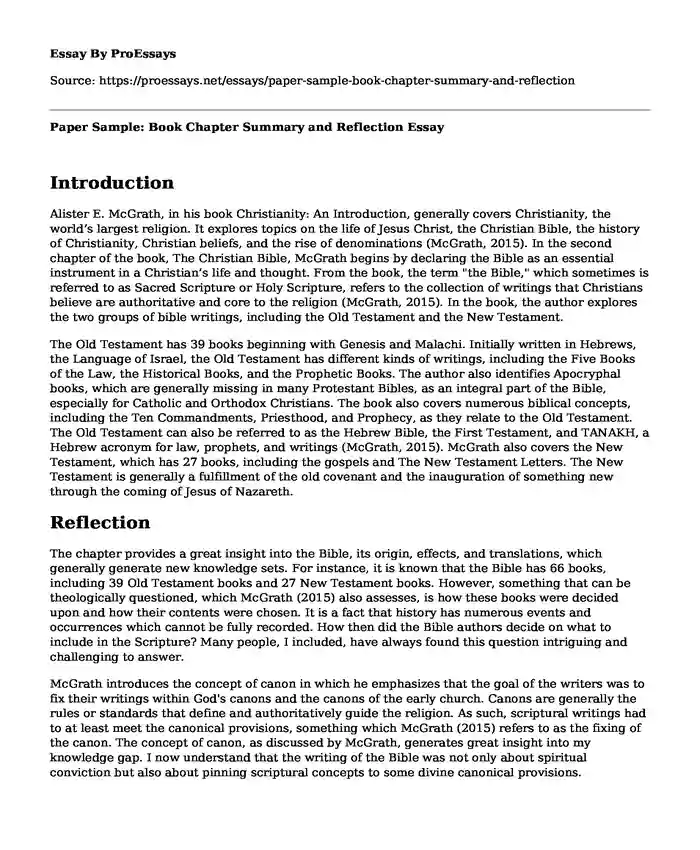Introduction
Alister E. McGrath, in his book Christianity: An Introduction, generally covers Christianity, the world’s largest religion. It explores topics on the life of Jesus Christ, the Christian Bible, the history of Christianity, Christian beliefs, and the rise of denominations (McGrath, 2015). In the second chapter of the book, The Christian Bible, McGrath begins by declaring the Bible as an essential instrument in a Christian’s life and thought. From the book, the term "the Bible," which sometimes is referred to as Sacred Scripture or Holy Scripture, refers to the collection of writings that Christians believe are authoritative and core to the religion (McGrath, 2015). In the book, the author explores the two groups of bible writings, including the Old Testament and the New Testament.
The Old Testament has 39 books beginning with Genesis and Malachi. Initially written in Hebrews, the Language of Israel, the Old Testament has different kinds of writings, including the Five Books of the Law, the Historical Books, and the Prophetic Books. The author also identifies Apocryphal books, which are generally missing in many Protestant Bibles, as an integral part of the Bible, especially for Catholic and Orthodox Christians. The book also covers numerous biblical concepts, including the Ten Commandments, Priesthood, and Prophecy, as they relate to the Old Testament. The Old Testament can also be referred to as the Hebrew Bible, the First Testament, and TANAKH, a Hebrew acronym for law, prophets, and writings (McGrath, 2015). McGrath also covers the New Testament, which has 27 books, including the gospels and The New Testament Letters. The New Testament is generally a fulfillment of the old covenant and the inauguration of something new through the coming of Jesus of Nazareth.
Reflection
The chapter provides a great insight into the Bible, its origin, effects, and translations, which generally generate new knowledge sets. For instance, it is known that the Bible has 66 books, including 39 Old Testament books and 27 New Testament books. However, something that can be theologically questioned, which McGrath (2015) also assesses, is how these books were decided upon and how their contents were chosen. It is a fact that history has numerous events and occurrences which cannot be fully recorded. How then did the Bible authors decide on what to include in the Scripture? Many people, I included, have always found this question intriguing and challenging to answer.
McGrath introduces the concept of canon in which he emphasizes that the goal of the writers was to fix their writings within God's canons and the canons of the early church. Canons are generally the rules or standards that define and authoritatively guide the religion. As such, scriptural writings had to at least meet the canonical provisions, something which McGrath (2015) refers to as the fixing of the canon. The concept of canon, as discussed by McGrath, generates great insight into my knowledge gap. I now understand that the writing of the Bible was not only about spiritual conviction but also about pinning scriptural concepts to some divine canonical provisions.
Another concern has been about the books included in the Bible. While the Protestant Bible sticks to 66 books, the Catholic Bible has more books. From the chapter, although they were not originally written in the Hebrew Language, the additional books in the Catholic Bible are part of the Christian tradition (McGrath, 2015). As the author puts it, the Protestants agree that these books are interesting and informative but conceive that they have no doctrinal importance because there not written in the Hebrew Language. Despite the contention on whether the additional books, formally referred to as Deuterocanonical books, should be included in the Bible, I now understand that they were part of the traditional Christian culture.
Conclusion
In conclusion, the book chapter is of immense importance in developing deeper insight into the Bible, the books in it, and finding answers to some of the most controversial questions surrounding the composition of the Scripture. It has also discussed conditions that informed the translation of the Bible.
Reference
McGrath, A. E. (2015). Christianity: An introduction. John Wiley & Sons.
Cite this page
Paper Sample: Book Chapter Summary and Reflection . (2023, Dec 28). Retrieved from https://proessays.net/essays/paper-sample-book-chapter-summary-and-reflection
If you are the original author of this essay and no longer wish to have it published on the ProEssays website, please click below to request its removal:
- Cultural Competence Through Multiculturalism Essay Example
- Murders Most Foul British Literature Detectives - Article Analysis Essay
- Essay on Iliad and Odyssey: Exploring Human Struggles in Epic Poetry
- Why Do Writers Write? Understanding Creativity & Flow - Essay Sample
- Essay on Modernist Dramatic Works: Meta-Theatre & Porosity of the Stage
- Lucille Clifton: A Tribute to the Power of African Womanhood - Essay Sample
- Essay Example on Shakespeare and Middleton's Timon of Athens: A Tale of Moral Conviction







